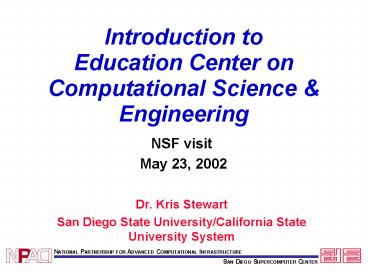Introduction to Education Center on Computational Science - PowerPoint PPT Presentation
1 / 16
Title:
Introduction to Education Center on Computational Science
Description:
University system of rewards must recognize & reward Interdisciplinary activities ... Rubin Landau, Oregon State University, Computational Physicist (undergrad degree) ... – PowerPoint PPT presentation
Number of Views:28
Avg rating:3.0/5.0
Title: Introduction to Education Center on Computational Science
1
Introduction to Education Center on
Computational Science Engineering
- NSF visit
- May 23, 2002
- Dr. Kris Stewart
- San Diego State University/California State
University System
2
The EC/CSEs Mission
2
- The EdCenters Mission is to
- foster the incorporation of high performance
research tools for scientific investigation into
the undergraduate curriculum - to better prepare learners for post-baccalaureate
activities where collaborative, interdisciplinary
teams, sophisticated computer tools, and
effective communication are used in research and
problem solving.
3
Engaging Broad Student Population
- Undergraduate faculty
- University system of rewards must recognize
reward Interdisciplinary activities - Curriculum development and team teaching
- Undergraduate students
- Major in Science or Engineering discipline
- Minor in Information Communications Technology
Dependent on local University Resources
Existing Programs, see Krell Institutes updated
list (Chuck Swanson)www.krellinst.org/learningcen
ter/CSE_survey.pdf
4
CalREN -2...
Resources
5
Building the Community of Faculty
- These challenges are people-centric, not
technology-centric and of interest to the HPC
community - Systemic Change requires understanding the system
and working within it - Empower teachers (find the time), recognition
(from chair/dean), support (student assistants)
6
Faculty Fellows Fall 01 Synergyamong themselves
and with their chairs and deans
People, Time, Support, Recognition
7
EC/CSE involves CSU
- Faculty Workshops
- Introduce Computational Science
- Host Biology Workbench (BioQuest)
- Support at NPACI AHM02
- Extend Faculty Fellows
8
Involving University FacultyInfrastructure for
Change
- NPACI/SDSU Faculty FellowsLocal Support from
College Deans and Department Chairs
(participation buy-in and faculty recognition) - SDSU Academic Advisors (across disciplines)
- CSU Deans and Chairs
- Professional Meeting (SC2001, SIAM, ACM, SIGCSE)
9
Assessment not just requirement
- Rather, found to be
- vital tool to assist in clarifying student and
faculty needs - improve prioritization skills
- validation of focus on human factors to integrate
HPC (modeling visualization) into undergrad
curriculum
U. Wisconsin LEAD for 1998/99 Ed Center
evaluation www.cae.wisc.edu/lead/pages/products/e
ot-paci.pdf
10
SWB Convenient Tool to Learn from Student Survey
Data
- Online tool for standard public data sets or
your own data set http//edcenter.sdsu.edu - Small Sample, therefore only useful as feedback
for the instructor - Can be used with forms interface directly into
SWB format, as in June 99 CSU Faculty Workshop
11
California Education Infrastructure
- K12 Education (standards based, performance
based) - Community Colleges (Freshman/Sophomore)
- Vocational
- University preparation
- California State University System (23 campuses)
- University of California (9 campuses, Merced in
2004) - Independents (Stanford U., CalTech, U. Southern
California)
12
California Education Infrastructure(testbed for
change)
- IMPAC http//www.cal-impac.org/Intersegmental
Major Preparation Articulated Curriculum
ProjectCommunity Colleges and Four Year
Universities - Charter Schools (Preuss School)
preuss.ucsd.eduDr. Rozeanne Steckler and Dr.
Mike BaileyFostering Scientific Curiosity in
All ChildrenSan Diego Supercomputer Center
13
Origin of the Automated Survey Creation Process
- EdCenter goal To promote the use of high
performance computing in the undergraduate
curriculum - Reforms in education often require evidence of
success before they are accepted - One form of evidence is assessment and evaluation
of the reformed program.
- Faculty Fellows program need for assessment
tools. - Sociology Workbench - Analysis of survey data
- Automated Survey Creation Process Collection
and storage of survey data
14
IMPACT of the Ed CenterThrough Conferences,
Workshops, Progams
- 1997 (Note ECCSE Open House 10 Oct 97 NPACI
startup 1 Oct 97)50 teachers (SC97 paper
presentation workshop) - 1998 80 undergrad students 30 university
undergraduate faculty - 1999 150 undergrad students 60 university
undergrad faculty 10 graduate students - 2000 250 undergrad students 120 university
faculty - 2001 230 undergrad students 100 university
faculty - 2002 200-100 undergrad students 80 university
faculty (so far)
15
Collaborations with NPACI and EOT-PACI
- DAKS at SDSC (using the Sociology Workbench in
classes and for analysis) - Rubin Landau, Oregon State University,
Computational Physicist (undergrad degree) - LEAD Center, University of Wisconsin, Madison
- NISE, Learning Through Technology
- Boston University and SUNY Brockport
- Student Biology Workbench, NCSA Beloit U.
- University of Houston, Downtown
16
More Information?
- Kris StewartProfessor, Computer Science,
SDSUDirector, ECCSE, NPACI/CSUstewart_at_sdsu.eduJ
eff SaleStaff Scientist, ECCSEjsale_at_edcenter.sds
u.eduKirsten Barber, Computer Resource
Specialistbarber_at_edcenter.sdsu.edu - www.edcenter.sdsu.edu































